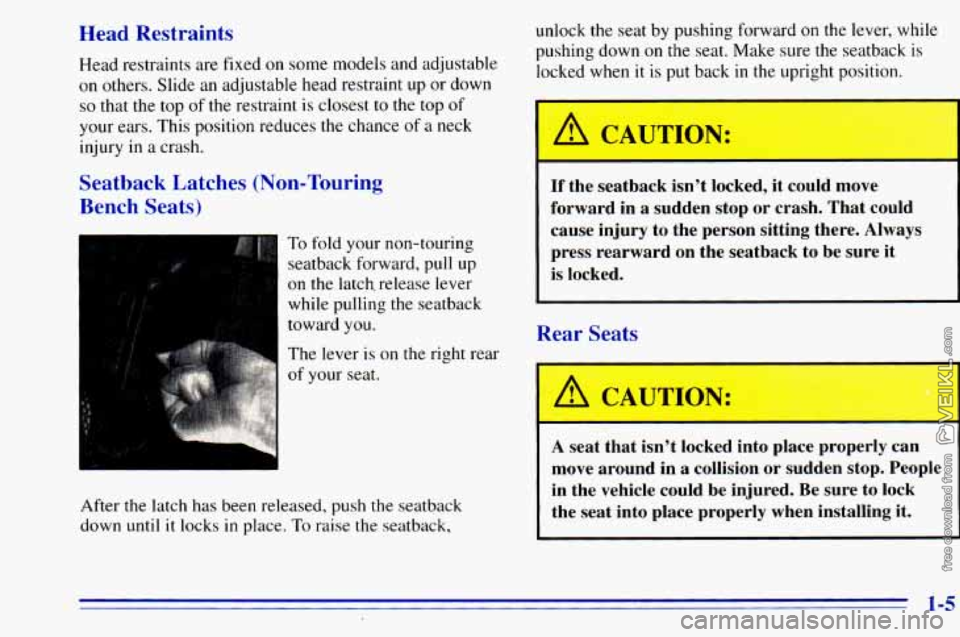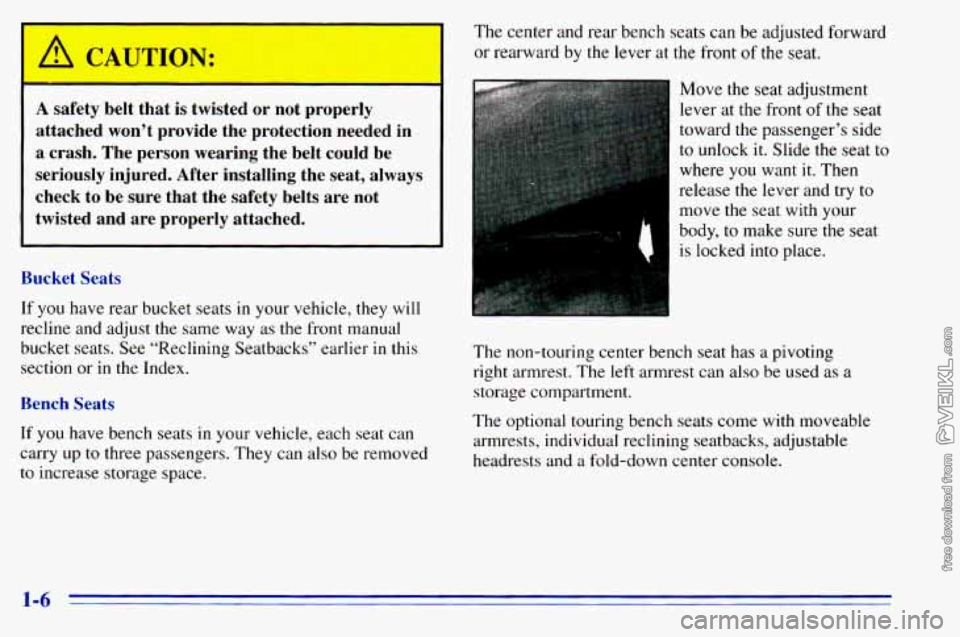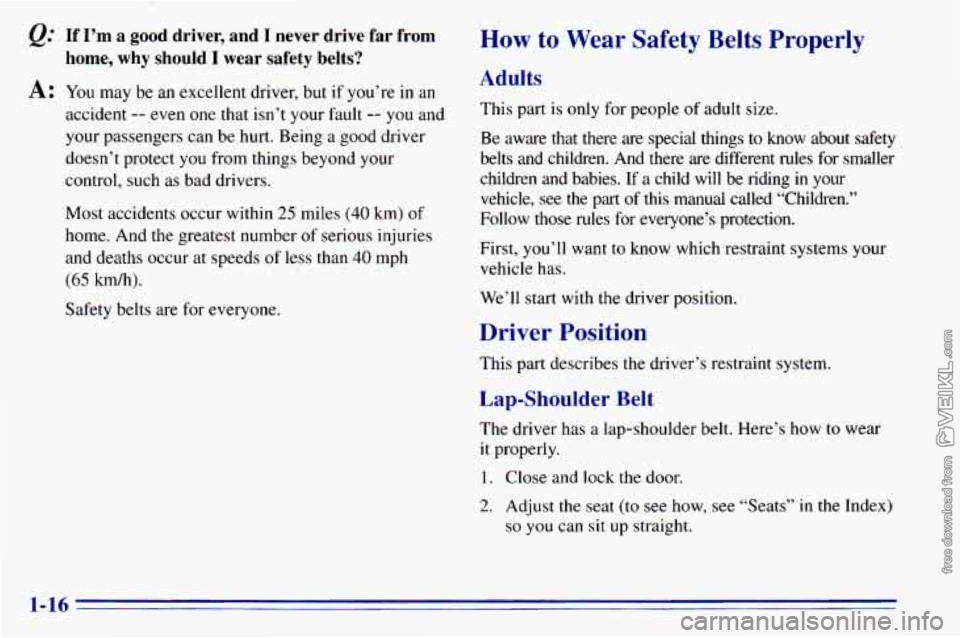Page 7 of 372
Vehicle Symbols
These are some of the symbols you may find on your vehicle.
For example,
these symbols
are used on an
original battery:
POSSIBLE A
CAUTION
INJURY
PROTECT EYES BY
SHIELDING
CAUSTIC
ACID COULD BATTERY
CAUSE
BURNS
SPARK
OR ,111,
COULD FLAME
EXPLODE BATTERY
These symbols are important
for you and
your passengers
whenever your
vehicle
is
driven:
DOOR LOCK
FASTEN SEAT
BELTS
These symbols have
to do with
your lights:
SIGNALS e
TURN
WARNING
A
HAZARD
FLASHER
FOG LAMPS
$0
These symbols are on
some of
your controls:
WIPER w
WINDSHIELD
DEFROSTER
VENTILATING FAN
(
-b
-J
These symbols are used on
warning and
indicator lights:
COOLANT -
TEMP -
CHARGING I-1
BATTERY
SYSTEM
BRAKE
(0)
COOLANT a
ENGINE OIL w,
PRESSURE
ANTI-LOCK
(@)
BRAKES
Here are some
other symbols
you may see:
FUSE
I
LIGHTER n
HORN )a(
SPEAKER
b
FUEL p3
V
Page 10 of 372
2-Way Front Seat
The bucket seats can be
adjusted forward or
rearward by the lever at
the front
of the seat.
Manual Lumbar Support (Option)
Move the seat adjustment lever at the front of the seat
toward the driver’s door to unlock
it. Slide the seat to
where you want it. Then release the lever and try to
move the seat with your
body, to make sure the seat is
locked
into place.
If you have this feature, there will be a knob on the
inboard side
of the driver and passenger bucket seats.
Turn the knob toward
the front of the vehicle to increase
lumbar support. Turn the knob toward the rear of the
vehicle
to decrease lumbar support.
1-2
Page 11 of 372
Power Seats (Option)
If you have this feature, there will be a control pad on the
inboard side of
the driver and passenger bucket seats.
Reclining Seatbacks
There is a lever on the inside of the seat to adjust
the seatback.
The front control makes the front
of the seat go up
and down.
The rear control makes the rear
of the seat go up
and down.
The center control makes the whole seat go forward
and rearward.
You can adjust the seatback
by lifting
the lever. Release
the lever
to lock the seatback
where
you want it. Pull up
on the lever and the seat will
go to an upright position.
1-3
Page 13 of 372

Head Restraints
Head restraints are fixed on some models and adjustable
on others. Slide an adjustable head restraint up or down
so that the top of the restraint is closest to the top of
your ears. This position reduces the chance of a neck
injury in a crash.
Seatback Latches (Non-Touring
Bench Seats)
To fold your non-touring
seatback forward, pull up
on the latch release lever
while pulling the seatback
toward
you.
The lever is on the right rear
of your seat. unlock
the seat by pushing forward on the lever, while
pushing down
on the seat. Make sure the seatback is
locked when it is put back
in the upright position.
After the latch has been released, push the seatback
down until it locks
in place. To raise the seatback,
If the seatback isn't locked, it could move
forward
in a sudden stop or crash. That could
cause injury to the person sitting there. Always
press rearward on the seatback to be sure it is locked.
Rear Seats
A seat that isn't locked into place properly can
move around in
a collision or sudden stop. People
in the vehicle could be injured. Be sure to lock
the seat into place properly when installing it.
Page 14 of 372

1 A, CAUTION:
A safety belt that is twisted or not properly
attached won’t provide the protection needed in
a crash. The person wearing the belt could be
seriously injured. After installing the seat, always
check to be sure that the safety belts are not
twisted and are properly attached.
Bucket Seats
If you have rear bucket seats in your vehicle, they will
recline and adjust the same way as the front manual
bucket seats. See “Reclining Seatbacks” earlier in this
section or in the Index.
Bench Seats
If you have bench seats in your vehicle, each seat can
carry up
to three passengers. They can also be removed
to increase storage space. The
center and rear bench seats
can be adjusted forward
or rearward by
the lever at the front of the seat.
Move the seat adjustment
lever at
the front of the seat
toward the passenger’s side
to unlock
it. Slide the seat to
where you want it. Then
release the lever and try to
move the’seat with your
body,
to make sure the seat
is locked into place.
The non-touring center bench seat has a pivoting
right armrest. The left armrest can also be used as
a
storage compartment.
The optional touring bench seats come with moveable
armrests, individual reclining seatbacks, adjustable
headrests and a fold-down center console.
1-6
Page 16 of 372
Removing the Rear Seats
To remove the rear seats, do the following:
7-7 I TO DETACH
1 BELT FOR 1
I SEAT REMOVAL
I
I! + iI
1 ANDIUSH 11
1 . INSERT KEY
INTO HOLE
I I I
1. If you are removing the
center seat, remove the
right lap-shoulder belt.
To do this, press the tip
of a
key into the release
hole
of the safety belt
attachment while pulling
up on the safety belt.
2. If you have a safety belt
guide on your seat, pull
the safety belt all the way
out through
the guide.
3. Pull up on the seatback latch on the right rear of the
front seat. Push the seatback down until it locks in
place (non-touring bench seats only).
1-8
Page 18 of 372
Replacing the Rear Seats
To replace the rear seats, do the following:
1. Lower the seat into position. Make sure the front
retainers are hooked onto the anchor pins.
2. Pull the seat down to latch the rear retainers. Make
sure the seat is locked in by pulling up and down on
the seat.
3. Raise the seatback by pushing forward on the latch at
the right rear
of the seat. Pull up on the seatback
until it
is locked securely in the up position.
1-10
Page 24 of 372

@ If I’m a good driver, and I never drive far from
A: You may be an excellent driver, but if you’re in an
home, why should I wear safety belts?
accident -- even one that isn’t your fault -- you and
your passengers can be hurt. Being
a good driver
doesn’t protect
you from things beyond your
control, such as bad drivers.
Most accidents occur within
25 miles (40 km) of
home. And the greatest number of serious injuries
and deaths occur at speeds
of less than 40 mph
(65 km/h).
Safety belts are for everyone.
How to Wear Safety Belts Properly
Adults
This part is only for people of adult size.
Be aware
that there are special things to know about safety
belts and children. And there are different rules for smaller
children and babies. If a child will be riding
in your
vehicle, see the part
of this manual called “Children.”
Follow those rules for everyone’s protection.
First,
you’ll want to know which restraint systems your
vehicle has.
We’ll start with the driver position.
Driver Position
This part describes the driver’s restraint system.
Lap-Shoulder Belt
The driver has a lap-shoulder belt. Here’s how to wear
it properly.
1. Close and lock the door.
?. Adjust the seat (to see how, see “Seats” in the Index)
so you can sit up straight.
1-16